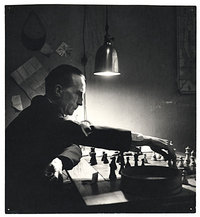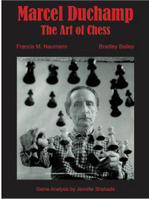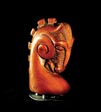Marcel Duchamp’s interest in chess is well-known: a self-described “chess maniac,” he played intensely, competed in tournaments, and carved his own set. At times, he absented himself from art to play chess almost exclusively; he encoded messages in his artworks that can only be understood by chess players.
 Now come two new entries on the subject that shed more light on the obsession. On May 6, the St. Louis University Museum of Art opened “Marcel Duchamp: Chess Master,” which attempts to “experience” his career “through the lens of his intense involvement with the royal game.” It features many of his works, like Trebuchet, the coat rack he nailed to his studio floor referencing a chess position, as well as chess-related works by other Dada and Surrealist artists, including Man Ray, Max Ernst, and Salvador Dali. Smartly, the show’s opening coincided with the United States Chess Championship in St. Louis. (Talk about new audiences: chess players around the world number in the hundreds of millions.)
Now come two new entries on the subject that shed more light on the obsession. On May 6, the St. Louis University Museum of Art opened “Marcel Duchamp: Chess Master,” which attempts to “experience” his career “through the lens of his intense involvement with the royal game.” It features many of his works, like Trebuchet, the coat rack he nailed to his studio floor referencing a chess position, as well as chess-related works by other Dada and Surrealist artists, including Man Ray, Max Ernst, and Salvador Dali. Smartly, the show’s opening coincided with the United States Chess Championship in St. Louis. (Talk about new audiences: chess players around the world number in the hundreds of millions.)
Here’s a link to the show and, since I have not seen it, to an article on the show and to a blog item on a panel held at the St Louis Chess Club, both from the St. Louis Post-Dispatch.
I was tipped off to all of this by Francis Naumann, the Dada/Surrealism expert who spoke at the St. Louis panel. He’ll be bringing the exhibition to his New York gallery on Sept. 10. And he and the exhibition’s curator are just out with a new book on the subject, Marcel Duchamp: The Art of Chess.
In it, Naumann argues that Duchamp’s life proceeded as if it were a chess game: opening,
 middle game, endgame. And not by happenstance. Rather, Duchamp orchestrated his life that way. Bradley Bailey, the curator/assistant professor at St
middle game, endgame. And not by happenstance. Rather, Duchamp orchestrated his life that way. Bradley Bailey, the curator/assistant professor at St
Louis University (Duchamp’s Chess Identity is the title of his dissertation), asserts that Duchamp’s art and his chess are so intertwined, aesthetically and conceptually, that they can not be separated — especially in his iconic work The Bride Stripped Bare by Her Bachelors. The book’s art images and photos are terrific.
The book also includes expert analysis of 15 of Duchamp’s chess game by Jennifer Shahade, a chess champion/writer. She recently posted on her website a video, Naked Chess, inspired by Duchamp’s game with a naked woman (a picture of which is in the book).
As she writes:
One great thing about playing against a naked man in chess is that there are no pockets for electronic devices, so you can be absolutely sure he is not cheating.

Here’s a link to her site.
Naumann, Bradley and Shahade have made much more of their Duchamp studies than the usual exhibition and book. They’ve made it participatory and fun. If you’re a chess player, you can join in animated Duchamp chess games by going to Francis Naumann’s website, and clicking on the chess icon shown at left.
(And while you’re there, take a look at the works currently on view, by a little-known American surrealist named Leon Kelly.)
Photo Credits: Archives of American Art (top); Francis M. Naumann Fine Art (bottom).
